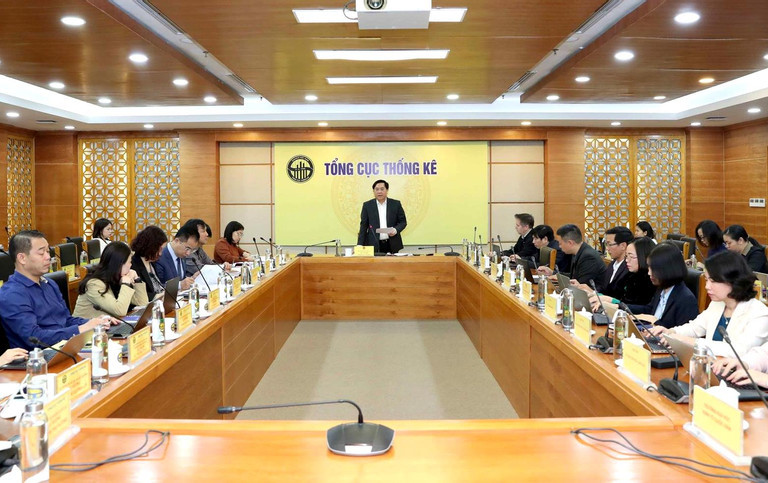
A workshop on measurement methods and the compilation of indicators for calculating the proportion of the digital economy’s added value in GDP (gross domestic product) and GRDP (gross regional domestic product) was held on December 4.
Nguyen Thi Thu Huong from the General Statistics Office (GSO) said the added value proportion of the digital economy in GDP was 12.75 percent in 2020-2022 and 12.67 percent in 2022.
Of these, the core digital economy made up 7.77 percent, accounting for 61.29 percent, while the digitization of other business fields contributed 4.91 percent, accounting for 38.7 percent.
If considering contributions by economic sectors, the contribution by the service sector to GDP was the highest, 6.59 percent in 2020-2022, while industry and construction was 6.11 percent. The lowest figure was seen in agriculture-forestry-seafood, just 0.05 percent of GDP in the same period.
The digital economy scale increased steadily in 2020-2022, which showed the government’s efforts in accelerating the development of ICT (Information and Communication Technologies) and intensified digitization activities. Particularly, services have been digitized, thus contributing increasingly high added value proportion in GDP, from 6.54 percent in 2020 to 6.61 percent in 2022.
Some localities had a high added value proportion of digital economy in GRDP in 2022, mostly thanks to electronics, and computer and optical products, including Bac Ninh (46.75 percent), Thai Nguyen (34.24 percent), Bac Giang (32.42 percent), Hai Phong (27.22 percent) and Vinh Phuc (24.67 percent).
The common characteristic of the localities is that they have attracted much foreign direct investment (FDI) capital to core digital economy activities. Therefore, the added value of core digital economy accounts for high 87-96 percent of total added value of the digital economy in the provinces.
Hanoi’s digital economy proportion is 15.41 percent (core digital economy accounts for 75 percent), while HCM City’s figure is 13.51 percent (69 percent).
According to Dau Ngoc Hung, head of the Hanoi Statistics Office, Hanoi’s digital economy is expected to account for 30 percent of GRDP by 2025.
Meanwhile, GSO said digital economy just accounted for 15.41 percent in 2022, which means a big gap between the implemented figure and the planned target.
“However, you still can see considerable progress of Hanoi’s digital economy proportion. Fifteen percent is still considered a high figure because Hanoi economy’s scale is large with GRDP of VND1.2 quadrillion. In other words, 15.4 percent is lower than 30 percent, but the absolute value is high.
The indicator has been calculated by many agencies and much research was done on this issue. The Ministry of Information and Communications (MIC), for example, said the proportion of Hanoi’s digital economy was 17.5 percent in 2022, while a research work of the National Economics University found that the figure of Hanoi was 23.5 percent in 2021, but the figure was just over 10 percent for the core economy.
Hung hopes that the assessment of the implementation of digital economy development plan of the entire country in general and Hanoi in particular will be more accurate.
A representative of the HCM City Statistics Office commented that the methods of calculation of digital economy proportion in GDP and GRDP and the approach figures are different.
The calculation of digital economy proportion of the whole country is based on the inter-sectoral balance sheet with both supply and demand approach.
Meanwhile, for provinces and cities, the calculation is implemented on the basis of digital value of applied information technology costs to create product values. If a common coefficient is applied to the whole country, this will affect the calculation results.
Mai Thi Thanh Binh from the National Institute for Information and Communications Strategy said it is very difficult to measure three factors as initially defined – core digital economy, digital platform economy and digital economy in business fields.
She said the institute is following the same approach as GSO, i.e. measuring the digital economy with two cycles – ICT core economy and digital economy pervasive in different fields.
She requested GSO and MIC to discuss and reach an agreement on the codes of business fields for ICT digital economy. Local information and communications departments and local authorities also want to be granted codes for better management.
GSO’s General Director Nguyen Thi Huong affirmed that the calculation of added value of digital economy in GDP and GRDP publicized by GSO is conducted on recognized theory and calculation method, which ensures international compatibility and consideration for Vietnamese conditions.
Manh Ha